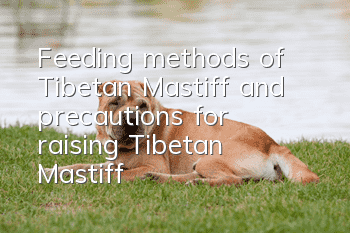Feeding methods of Tibetan Mastiff and precautions for raising Tibetan Mastiff

The Tibetan Mastiff is a large dog with a ferocious personality. Dogs like this, which are large and ferocious, are extremely sensitive to the approach of strangers. It is best not to go to crowded places to avoid biting people. But there are also some friends who love Tibetan mastiffs and raise Tibetan mastiffs. So how should we feed Tibetan Mastiffs? What matters should be paid attention to when raising Tibetan Mastiffs? Today, the editor will bring you the feeding methods of Tibetan Mastiffs and some precautions for raising Tibetan Mastiffs.
How to feed Tibetan Mastiff:
1. The food water and raw materials used to feed Tibetan Mastiffs must be kept clean and cleaned. Food should be cooked well to avoid food poisoning. In addition, the feeding utensils and mastiff house must be cleaned regularly to prevent the invasion of parasites and bacteria. Deworm on time.
2. The Tibetan Mastiff should not be allowed to do strenuous exercise before and after feeding, and any leftover food residue should be taken away in time. When feeding fish, chicken and other foods with thorns or bones, the thorns and bones should be removed to avoid damaging the little Tibetan Mastiff's mouth and intestines.
3. The baby Tibetan Mastiff’s deciduous teeth have been fully developed. You can pressure-cook the ribs and let the baby Tibetan Mastiff chew and bite them to stimulate the development of its gums, which will help the growth of permanent teeth.
4. Tibetan Mastiffs should eat small meals frequently, and can appropriately increase necessary nutrients such as meat, dairy products, calcium, and cod liver oil. Little Tibetan Mastiffs have a habit of gluttony, so they must be taken care of when feeding. Because the little Tibetan Mastiff should not be fed too full, generally 70% to 80% is enough. Otherwise it will lead to overfullness and indigestion.
5. When feeding the Tibetan Mastiff, you must pay attention to it. The person who feeds cannot change the timing, quantity, etc. at will. You can train the Tibetan Mastiff's eating habits. The location and tableware cannot be changed at will to avoid affecting the mood of the little Tibetan Mastiff.
Precautions for raising Tibetan Mastiff:
1. Because the little Tibetan Mastiff has just changed to a new environment, in order to prevent acclimatization, drink bottled pure water for the first half of the month, and then slowly switch to cold boiled and raw water. Make sure to keep clean drinking water next to the little Tibetan Mastiff.
2. Don’t rush to feed the Tibetan Mastiff after getting off the car. Drink some pure water first, then feed a raw egg one hour later, and then feed another raw egg every two hours. The eggs should be at room temperature. Do not feed them right after taking them out of the refrigerator. This is the first meal. Don't feel sorry for the Tibetan Mastiff before feeding him anything else. The main purpose of this step is to empty his stomach and clear his stomach. On the second day, you can feed a small amount of about one or two at a time. Feeding three times a day is enough. After that, you can gradually increase the amount of food and the frequency of feeding. Do not feed meat in the first week, and do not feed eggs after they are born.
3. It is best not to air-condition Tibetan Mastiffs in summer, otherwise they will easily get sick when they go outdoors.
4. If the little Tibetan Mastiff is sick, it is best not to give an intravenous drip. It is best to use human medicine instead of veterinary medicine.
5. It is best for Tibetan Mastiffs to eat dog food for a long time during their growth stage. I use Nori, and I heard that the best one is Guanneng, but the price is very high. They eat puppy food in the first year, and can later switch to adult or large dogs. grain. It is recommended to buy a barrel of IN from the United States. The price is about 300. It can last for a year, which is equivalent to Amway for human consumption. This is very good and can be found online.
6. After one month, you can gradually add a little meat and bones to the food, preferably beef and beef bones. It is best to boil the bones until they are soft before eating them. As the little Tibetan Mastiff grows, you can gradually increase the amount of meat it eats, but you cannot eat only meat. , otherwise the Tibetan Mastiff cannot lack meat.
7. The most common troubles for Tibetan Mastiffs are gastrointestinal diseases and colds. Pay attention to whether his stools are in strips or piles. If the stool is loose and not in piles, you should take some human antidiarrheal drugs such as norfloxacin. In order to prevent this kind of disease, you can take oxytetracycline and gentamicin regularly. This is very important and effective. Pay attention to whether the dog's nose is moist. If the nose is dry and the dog does not breathe through the mouth, it means he is sick. You can contact me at any time. If it is serious, he will have to be sent to the hospital.
8. Little Tibetan Mastiffs love to bite things at home. It is recommended to buy a teething stick, which is available at the dog market. It is usually made of cowhide and beef tendon. This is very important for the development of the little Tibetan Mastiff’s teeth.
9. It is best not to take the Tibetan Mastiff out or come into contact with other dogs before the epidemic prevention is completed, let alone take the Tibetan Mastiff to the dog market.
10. Finally, I advise you not to hit the Tibetan Mastiff, but to take good care of the Tibetan Mastiff. You can reprimand the Tibetan Mastiff loudly when training or disobedient, otherwise the results will be in vain.
Prevention and treatment of Tibetan Mastiff diseases:
1. Tibetan Mastiffs should be dewormed for healthy and disease-free adult dogs and puppies in spring, and the breeding place and surrounding environment should be thoroughly cleaned and disinfected.
2. Ten days after the Tibetan Mastiff is dewormed, and the weather is good, all dogs should be vaccinated and carry out annual program epidemic prevention. Only puppies after 50 days of age can be vaccinated. And strictly prevent outsiders from entering the dog farm to prevent the spread of infectious diseases. At the same time, appropriately put some antibiotics in the feed, and do a good job of focusing on prevention and supplementing treatment.
3. Late spring is the season for Tibetan Mastiffs to shed their hair. They shed their winter hair and grow summer hair. Therefore, the dog’s shed coat should be combed promptly and frequently to prevent the reproduction and infection of bacteria, fungi and external parasites, which may cause skin diseases.
- Things to note when weaning your puppy
- How to Feed Pets Treats
- How old can a Smiling Angel Samoyed be to train? Tell you how to train Samoyed
- Does your dog show his belly just because he trusts you?
- Can female dogs be neutered?
- Dog's stool is shapeless
- How to avoid encephalitis in dogs
- What should I do if my dog picks up random things and eats them?
- At what age is it appropriate for Teddy to start training?
- Why are Shiba Inu so cute?



